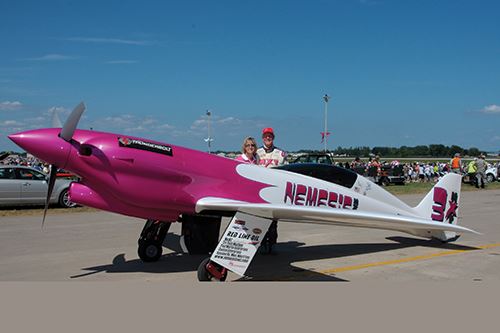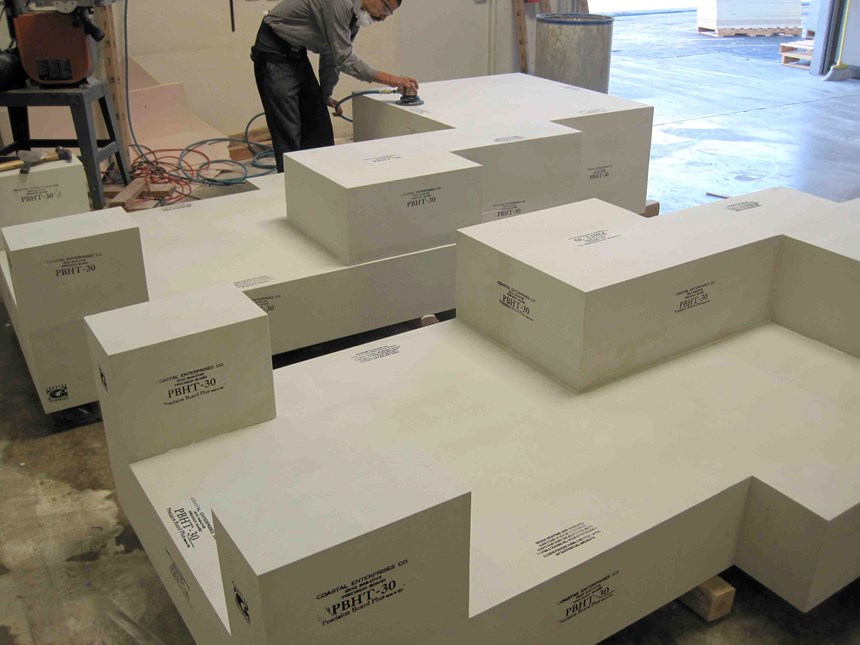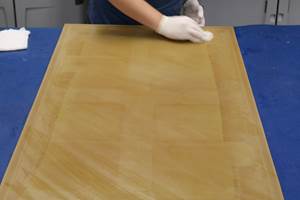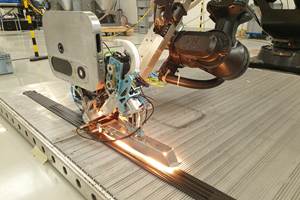Low-rate layup tools made cost-effective with high-density polyurethane foam blocks
Nemesis Air Racing, an air racing team and kit-plane company owned and operated by Jon and Patricia Sharp, use prebonded closed-cell, polyurethane foam blocks to build the Nemesis NXT.
Nemesis Air Racing (Oro Valley, Ariz.) is an air racing team owned and operated by Jon and Patricia Sharp. Formerly a composites engineer at Lockheed Martin Skunk Works (Palmdale, Calif.), Jon Sharp is a legendary air racer: He won the Reno Air Racing National Championships nine consecutive times in a tiny International Formula 1 racing aircraft, dubbed Nemesis, which he and his team developed and fabricated in the early 1990s. The most successful aircraft in air-racing history, the original Nemesis is on display in the Smithsonian National Air and Space Museum (Washington, D.C.). When Sharp decided to build a larger composite racer, the Nemesis NXT, an unexpected rule change mandated that each participating aircraft had to be available for purchase as a kit. Fortunately, the Nemesis name ensured that the required five kits were quickly sold. Sharp and his team were then faced with producing the carbon fiber/epoxy composite kit elements from CAD file data.
Based on his extensive experience at Skunk Works, Sharp understood the benefits of soft tooling for prototyping and limited production: “We were drawn to high-density polyurethane because of the greater level of design flexibility that was available. The inevitable design changes were much less of a headache than with metal tools.”
Coastal Enterprises Co. (Orange, Calif.) supplied Sharp with Precision Board Plus, a 20 lb/ft3, closed-cell, polyurethane foam in customized, prebonded shapes, to create the molds for the NXT’s horizontal and vertical tail, leading edges, interior components and the craft’s 90-gal gas tank. The prebonded shapes saved time and labor during CNC-machining with standard cutting tools, because less material had to be machined to achieve the final mold shapes. As Sharp told Coastal Enterprises, “The foam molds gave us our most accurate airframe ever produced. The tight cell structure and ease of machining enabled us to bring our first computer-designed aircraft to life.”
“If you make the decision to buy metal tooling, you’re constrained by a lot of factors — higher cost, size and weight and overall lead time for the tool build,” contends Coastal Enterprises president Chuck Miller. “High-density urethane foam offers much more flexibility and speed, and the coefficient of thermal expansion can be easily compensated for.” Precision Board Plus reportedly is suitable for tooling applications up to 300°F/149°C, is available in densities from 4 lb/ft3 up to 75 lb/ft3, and can be autoclave-cured, says Miller. He also explains that Coastal’s ability to bond polyurethane foam blocks together in the approximate shape of a final tool (see photo, lower left) prevents bondline voids, which can cause “chunking” of the material during machining (custom mandrels in any size are also on offer): “We formulate our own EP76 epoxy adhesive to match the density of the material,” says Miller, “which helps reduce collet chatter witness lines in the part.”
Miller adds that, in the past, polyurethane foam tools earned a reputation for “inhibiting cure” of carbon/epoxy prepregs due to its out-gassing during heating. In fact, he says, this inhibition of cure can also occur due to out-gassing of some tool sealers. Any out-gassing from the tool during heating, whether it originates from the tooling board, or any sealer, filler, or etc., can react with the epoxy resin and inhibit the composite cure. "Precision Board Plus, in both PBLT 200ºF and PBHT 300ºF formulations, have proven over the years they do not out-gas, contends Miller. "All high-density urethane tooling boards are a fairly good insulator and, therefore, not a good heat conductor and so do not readily conduct temperature." They need time for temperature change (i.e., ramping time, for temperature absorption or release). The typical temperature ramping time for high-density urethane is two minutes per degree Fahrenheit, going up in temperature, and one minute per degree Fahrenheit coming down. "Ramping both directions is critical to allow the CTE expansion and contraction to normalize without causing stress risers and possible cracking. This also allows some extra time for complete layup cure," he notes, adding, "It is always recommended to discuss specific composite applications with the manufacturer prior to layup."
Related Content
Fyous launches infinitely reusable manufacturing mold tech
PolyMorphic Moulding technology uses 28,000 digitally controlled pins to create a shape from a 3D CAD shape in less than 20 minutes, achieving zero waste and enabling parts production 14 times faster than 3D printing.
Read MoreProper application of semi-permanent mold release systems
Performing regular maintenance of the layup tool for successful sealing and release is required to reduce the risk of part adherence.
Read MoreJamco America partners with Airtech for 3DP tool recycling
Aerospace manufacturer joins forces with composite materials company to achieve sustainable manufacturing practices that overcome traditional composite layup tooling.
Read MoreATLAM combines composite tape laying, large-scale thermoplastic 3D printing in one printhead
CEAD, GKN Aerospace Deutschland and TU Munich enable additive manufacturing of large composite tools and parts with low CTE and high mechanical properties.
Read MoreRead Next
All-recycled, needle-punched nonwoven CFRP slashes carbon footprint of Formula 2 seat
Dallara and Tenowo collaborate to produce a race-ready Formula 2 seat using recycled carbon fiber, reducing CO2 emissions by 97.5% compared to virgin materials.
Read MoreDeveloping bonded composite repair for ships, offshore units
Bureau Veritas and industry partners issue guidelines and pave the way for certification via StrengthBond Offshore project.
Read MoreVIDEO: High-volume processing for fiberglass components
Cannon Ergos, a company specializing in high-ton presses and equipment for composites fabrication and plastics processing, displayed automotive and industrial components at CAMX 2024.
Read More
























